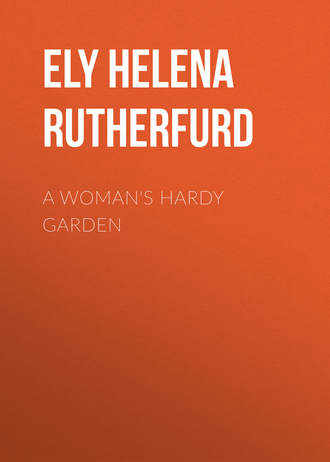 полная версия
полная версияA Woman's Hardy Garden
June thirteenth
Wherever there is a fence make a border, wide or narrow according to your space; if wide, – and it may be as much as twelve feet wide, – always make the edge irregular, never straight. Some prefer a hedge at the back of the border. The best effect and quickest screen is made by planting, against the fence at the back of the border, White Lilacs (not the Persian), Syringas, Deutzias and the beautiful new Altheas. Plant these shrubs three feet apart. In good soil they will send up great canes, and in four years time should be six feet high and shut you in from all prying gaze.
In planting a border, always keep in mind the fact that it should be blooming from May to November. Put in the plants according to height, the tallest, of course, at the back and the lowest in front, filling the front also with spring-flowering bulbs, Daffodils, Tulips and Narcissi, which will blossom and be over before the plants come on. You will thus have the longest succession of bloom. If the border is quite wide – from four to six feet – and perhaps one hundred and fifty feet long, it will hold a surprising number of plants.
Certain plants, in a long border with a background of shrubs, look best in rows, in spite of all that has been written against it: For instance, Hollyhocks, a long row of plants three deep, broken every ten feet or so by a clump of a dozen, and in front of these a single row of Rudbeckias, broken with clumps of six or so, and the rest of the border planted in masses, more or less according to space, of Phloxes, Larkspur, Lilies, Columbines, Sweet Williams, with every now and then a good clump of Chrysanthemums to blossom when all other flowers are gone.
In filling a border along a rather short path, the plants should always be set in clumps of from six to twelve of a kind. If the border is narrow and has no shrubs or hedge back of it, the effect will be better if the plants do not exceed three feet in height. Omit from such a border Hollyhocks, Rudbeckias, Sunflowers and Cosmos. Sweet Williams, Columbines, Sweet Alyssum, Candytuft, Nasturtiums and Phlox Drummondii can all be grown as edging for borders.
I have a border, two and a half feet wide and three hundred and fifty feet long, that is a mass of bloom from the middle of May until the last of September.
It may give the reader a suggestion to know its contents. Everything is in rows, the only border in my garden where the planting is done in this way. Along the edge is Narcissus Poeticus; back of Narcissus Poeticus a row of Sweet Williams, pink, white and very dark red; back of the Sweet Williams, Foxgloves; back of the Foxgloves, Peonies and Hydrangea grandiflora planted alternately; and back of these, a row of Hollyhocks. About two feet behind this border, a row of Rudbeckia (Golden Glow) grows like a tall hedge.
When Narcissus Poeticus has finished blooming, the Peonies come on. Before the last Peony has lost its petals, the Sweet Williams (quite two feet high) are in blossom, and the Foxgloves (from three to four feet high) begin to bloom, and last for a month. While these flowers are still lovely, the tall Hollyhocks begin to flower, each plant sending up from three to five stalks. Then, by the time the Hollyhock stalks are cut down, the Hydrangeas, which are trimmed back very severely every autumn, are a mass of white. Meanwhile the Rudbeckias, for quite six weeks, form a yellow background. The illustrations show this row of flowers while the Narcissi, Peonies, Foxgloves, and Hydrangeas are successively in blossom.
Early in June, I transplant into perennial borders, wherever a spot can be found, clumps of Asters, Cosmos and other late annuals, which are beautiful in September and October when most flowers have ceased to bloom.
From September twentieth to October fifteenth is a busy time in the garden. New beds and borders should be made then. The plants in all borders four years old should be lifted, and the beds or borders spaded deeply with plenty of manure, the plants reset, and the young perennials transplanted from the seed-bed into their final places. All perennial plants whose roots are sufficiently large, should now be divided and reset. This fall planting and transplanting should be done at about the time mentioned, for the shrubs and plants must become well rooted before the ground freezes, or they will rarely survive the winter. No matter how rich a bed or border may be, I always have the hole to receive the plant made larger than is necessary, and put a spadeful of manure in the bottom. In transplanting, my man always has a wheelbarrow of this at his side to work from.
If there are bare places in lawns or grass paths, sow grass seed about the twentieth of September, then roll, and the grass will be well rooted before cold weather.
It must be borne in mind that everything possible should be done in the fall. Perennials start early in the spring, and it is a pity, when they are once started, to disturb them. When the frost has finally killed everything, all the dead tops should be cut off at the ground, the dead annuals pulled up, the borders made clean and neat, and, about the last of November, covered with a good layer of stable litter, leaves or straw. I have always found the plants start earlier and do better for this slight protection.
Whenever I tell my inquiring friends of the proper preparation of beds, and the spring top-dressing, and winter covering with manure, there is generally an exclamation of alarm at the quantity used. But much is required to make the garden grow. I call upon the farm for manure when the stable supply is insufficient, and both my farmer-husband and his manager at times look askance. But how can I live unless my garden has what it needs! The farmer-husband looks upon my gardening as a mild species of insanity, and cannot understand why a little garden with a few plants is not enough for any woman. By dint of much showing and explanation through many years, he has acquired a floricultural knowledge which enables him to tell a Rose, Lily, Sunflower and Phlox, and of this knowledge he is proud.
All manure should be drawn out into the garden when the ground is still frozen, in March or earlier, and placed in convenient piles, so that the ground may not be cut up, when soft, by the wagon wheels; and also to facilitate work when the first spring days come, and there are a hundred things to be done. If possible, have a spadeful of well-rotted stable manure stirred into the ground around each shrub and vine in early spring. The result will amply repay you. Save all wood-ashes carefully, under cover, for the garden, and scatter them on the beds and on the grass. Get well-ground fresh bone-meal, and let all plants have only a handful in the spring, and the reward in bloom is great. To have good results from the hardy Chrysanthemums the soil cannot be too rich, and I generally “give them something to eat,” as a boy who helps in the garden calls it, about the fifteenth of June and the fifteenth of August.
Care must be taken, in using bone-meal, not to put on too much, and to keep it away from contact with the rootlets.
ANNUALS
CHAPTER VII
ANNUALSThere are so many annuals that I will write only about the few which are easiest to grow and are most desirable. For me a flower must have merits for decorating the house as well as for making the garden beautiful.
The other day I found an English book on flowers, and at once sat down to read it, expecting enjoyment and profit from every page; but at the end of a few minutes I came upon the following paragraph:
“Particularly to most women one of the chief uses or functions of a garden is to provide flowers to be cut for the decoration of rooms. But I hold that a flower cut from its plant and placed in a vase is as a scalp on the walls of a wigwam.”
And I read no further in that book.
I grow flowers to gather them, both for the house and to give away. We keep about sixty vases full in the house from late May until October, and never allow more than two colours in the same room. I have a yellow room, where only yellow and white flowers, or white and blue, are permitted; a pink room, for white and pink or pink and crimson flowers; and a hall, whose dominant tone is a rich red, where the flowers are red and white.
Some of the annuals, like Mignonette and Poppies, must be sown where they are to grow. Mignonette does best in cool, rather moist soil.
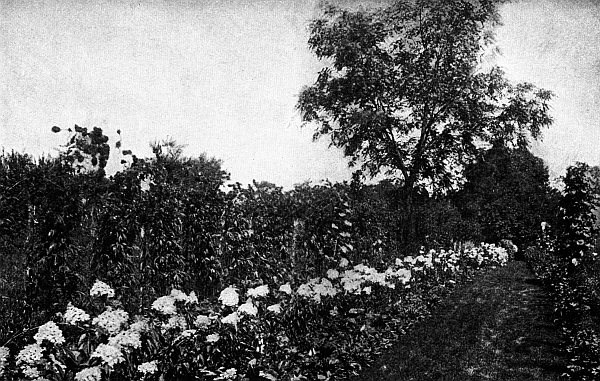
Long grass walk, with Hydrangeas; Rudbeckias in the background
August twenty-fifth
Poppies, and oh! have plenty of them and all kinds. Get the Shirley Poppies, the Giant Double, the fringed kind, and the California with their sunny petals. Sow in great numbers wherever they are wanted, here and there in the borders wherever there is space. If there is no other place, sow them in rows in the vegetable garden. They are splendid in the house, but, alas! fall too quickly.
The Shirley Poppies are almost like fairy flowers, they are so delicate and beautiful. They are the first of the annual Poppies to bloom. Then comes the variety which grows wild in France and Germany, – scarlet, with black blotches at the base of the petals. Last to bloom are the tall, fringed double and single Poppies, – white, pink and scarlet, growing on strong stems three feet high. Poppies must be sown thinly and the earth only sprinkled over the seeds. Sow as early in the spring as the ground can be worked, and thin out to six inches apart when the plants are well up.
Nasturtiums, too, should be planted where they are to grow, also Sweet Alyssum and Candytuft. All of these make good edgings for borders. If not allowed to go to seed they will bloom all summer.
Sunflowers, the Dwarf Double, and the tall Giant Sunflowers, are fine in backgrounds and against fences.
The Following Annuals Should be Sown in the Seed-bedAbout April Twentieth to May FirstAntirrhinum, or Snapdragon, growing eighteen inches high. If sown in early May they will bloom from August until late autumn. The same is true of the German Ten-weeks Stocks, which have a long period of bloom. The white ones are most lovely.
Asters, all varieties; sow a quantity. They are not only beautiful, but they give an abundance of blossoms in late September and early October, when flowers are beginning to be scarce. I prefer the Giant, Comet, Ostrich Plume and the late-flowering branching kind. Of these last, “Purity” (snow-white) and “Daybreak” (shell-pink) are the best, often bearing thirty flowers on a plant and lasting, in water, five days. A small quantity of wood-ashes stirred into the soil of the Aster bed is a fine fertilizer and destroys insects that attack the roots. Transplant in June to wherever they are to blossom.
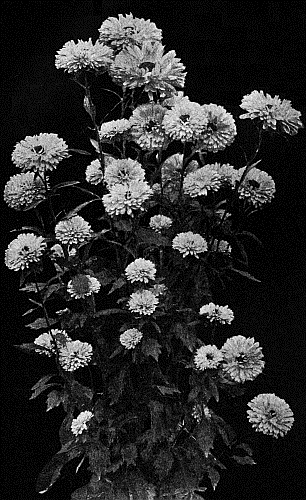
A single plant of Asters
September tenth
I have lately learned, that the only way to destroy the black beetle which appears upon the Asters and eats the flowers, is to have them picked off morning and evening and thrown into a pan containing kerosene oil, which kills them.
Cosmos. The early-summer flowering variety of Cosmos will begin to bloom in July, and, if not allowed to go to seed, will be a mass of flowers until killed by frost. In favorable soil Cosmos grows luxuriantly, and resembles a small tree six or eight feet high. This plant should be staked, or it is likely to be blown down. It is very effective when transplanted to the borders, blooming gayly when there is not much else. The pink and crimson varieties are beautiful, but do not compare with the white.
Calendula, growing about a foot high in every shade of yellow from deep orange to pale ivory, is one of the best and most constant blooming of the yellow flowers.
Centaurea, or Cornflower. These come in many colours, but I grow only the tall, ragged, blue variety. If not permitted to go to seed, they will bloom plentifully for several months. On the dinner-table with blue and white china, and in June combined with Syringa, they make a beautiful and unusual decoration.
Marigold, both the double African and the double French. These flowers always give me a pricking of the conscience, for during the summer, when there are plenty of others, I give them the “go by,” but in October turn to them with shame and thankfulness.
Phlox Drummondii grows about six or eight inches high, and comes in many colours. It makes beautiful borders, particularly the white, pink and dark red.
Plumed Celosia, or Cockscomb. The new varieties are very effective.
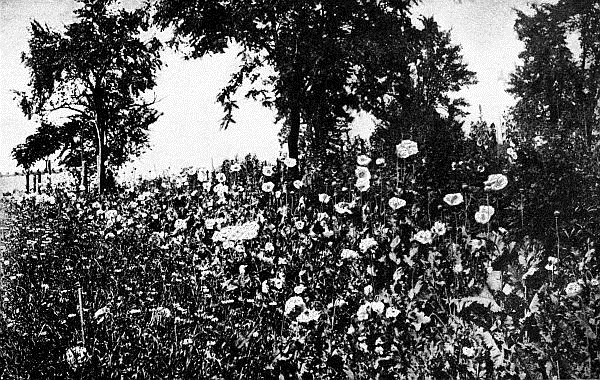
Poppies growing in rows
July fourteenth
Zinnias. Lately I have grown only two varieties, a vivid scarlet and a salmon-pink. They are not only lovely when growing, but make a beautiful house decoration, as the stems are long and stiff.
Sweet Peas, which no garden can do without. Several books say, plant in autumn, very late. I have twice sown two pounds at this time, carefully following the directions, and not one single Pea came up the following spring. Sweet Peas should be sown in the spring the moment the frost comes out of the ground, so that they may become deeply rooted before dry weather. Make a trench about a foot deep and a foot wide. Have a good layer of manure in the bottom of the trench, over which put a couple of inches of earth, and over this earth put a good layer of wood-ashes, again a sprinkling of earth. Then sow the Peas, and cover them with a couple of inches of earth. As they grow, fill in the trench, and keep on hilling up the plants until the roots are very deep. It is well to mulch them with the clippings of lawn grass. In this way the plants are kept from drying up, and will bloom until October.
Sweet Peas flourish best on a trellis of galvanized wire netting. It should be a permanent trellis, made of cedar posts set three feet deep, so as to be below the frost line and four feet high. To this attach the wire netting. A trench should be made on either side of the netting, so that a double row of Peas may be sown. The quantity sown depends on the length of the trellis; three pounds will sow a double row one hundred and twenty-five feet long. I always sow the different colours separately. It simplifies the task of arranging them, if they can be gathered separately. A bowl of white Sweet Peas and Maidenhair Fern is indeed a “thing of beauty.”
Pansies, every one loves them. They are annuals, but do best if treated as biennials. The most practical hint that I was able to get from “Elizabeth’s German Garden” was where she spoke of carpeting her Rose beds with Pansies. This instantly appealed to me, as I greatly dislike to see the earth in the beds and borders, and in Rose beds it always is to be seen. So I bought an ounce each of white and yellow Pansy seed, sowed it about the tenth of July in the partly shaded end of the seed-bed, and by October first had splendid great plants. I did not allow these to blossom, but picked off the buds, and, after the Rose beds had been given a plentiful top-dressing of manure carefully stirred in with a large trowel, I transplanted my Pansy plants. Of course, they had to be covered over with the Roses the last of November, and often during the winter I wondered whether the dears would be smothered. On the twenty-eighth of March the beds were uncovered, and, imagine it! there were Pansies in bloom. From April tenth until late in August these beds were simply a carpet of white and yellow. I never saw anything like it. It was probably due to the rich soil, perhaps also to the free watering necessary for the Roses. Then, in order that no Pansies should go to seed, my own maid, who is very fond of flowers, undertook each morning to cut off all that were beginning to wither. This required from one to two hours, but certainly prolonged the bloom, and I could never have spared a man so long for just the Pansies. Sow Pansy seed in the seed-bed about the tenth of July, and transplant late in October.
These are some of the more important annuals which no garden should be without. All of them are easy to raise, and blossom abundantly. I do not speak of the many others, but advise trying new flowers every year.
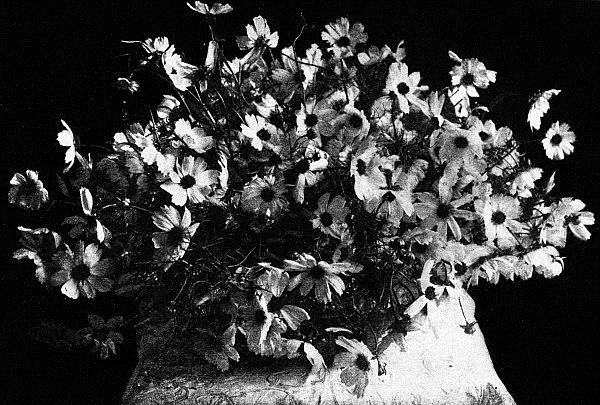
A Bowl of Cosmos
September twenty-ninth
The first week in June is the time to transplant all annuals. Do it, if possible, directly after a rain, always late in the afternoon, and, of course, water well after transplanting. I have a method of my own for the transplanting of seedlings, and by following it the tiny plants never wither or are set back, and in fact do not seem to know that they have been moved. Take a tin box, such as biscuits come in, half fill it with water, then lift into it from the seed-bed about one hundred seedlings at a time. With a sharp-pointed stick make holes in the bed where the little plants are to go, and then put them in. Soak the ground thoroughly after each patch is finished. In this way the tiny rootlets never become dry.
All the beds and borders can be kept free from weeds and in good condition if gone over with a trowel every five days, or once a week, the earth stirred thoroughly, and any weeds that may have grown taken out. It is particularly necessary, for a few weeks in the spring, to keep well ahead of the weeds. I always think of my sins when I weed. They grow apace in the same way and are harder still to get rid of. It seems a pity sometimes not to nurture a pet one, just as it does to destroy a beautiful plant of Wild Mustard, or of Queen Anne’s Lace.
List of Annuals, with Height, Colour and Period of BloomingAsters, all colours; one to two feet; August to October.
Alyssum, white, dwarf for borders; six inches; blooms all summer if not allowed to go to seed.
Balsam, Camellia-flowered, pale pink, dark red, white; two to three feet; July and August.
Calendula (Pot Marigold), all shades of yellow; mid-July until killed by frost.
Calliopsis (Coreopsis), yellow with red or brown center; two feet; mid-July, until killed by frost.
Candytuft, red, white, purple, Empress variety white the best, fine for edging; six inches; blooms continually if not allowed to go to seed.
Centaurea (Cornflower), all shades of blue; three feet; blooms three months if kept cut.
Cockscomb, crimson and scarlet; two to three feet; August and September.
Cosmos, white, pink, crimson; three to five feet; from the fifteenth of July until killed by frost.
Eschscholtzia, yellow Poppies; one foot; blooms all summer.
Godetia, pink, crimson, white; one foot; blooms all summer.
Marigold, all shades of yellow; one to two and one-half feet; mid-July until killed by frost.
Mignonette, average height one foot; blooms all summer if kept from seeding.
Nasturtiums, all shades of yellow and red; dwarf, nine inches; climbing, five feet; bloom all summer until killed by frost.
Pansy, many colours; six inches; from early spring until November, if kept well cut.
Petunia, double giant-flowered the only kind to raise; white, crimson and pink; one and one-half feet; bloom all summer.
Phlox Drummondii, many colours; one foot; blooms July, August and September if not allowed to seed.
Poppy, all shades of pink and red, also white; one to three feet. If several varieties are planted can be had in bloom from three to four weeks; end of June and July.
Snapdragon, scarlet and white, white and yellow, pure white; one and one-half feet; July and August.
Stocks (German Ten-Weeks), white, pink, red, purple; one and one-half feet; middle of July until middle of September.
Sunflower, yellow, dwarf and tall varieties, single and double; three to six feet; all summer.
Sweet Peas, all colours; three feet; grown on bush or trellis; end of June until October if kept well cut and moist.
Sweet Sultan, purple, white, yellow; one and one-half feet; June, July and August.
Zinnia, many colours; one and one-half to two feet; July, August and September.
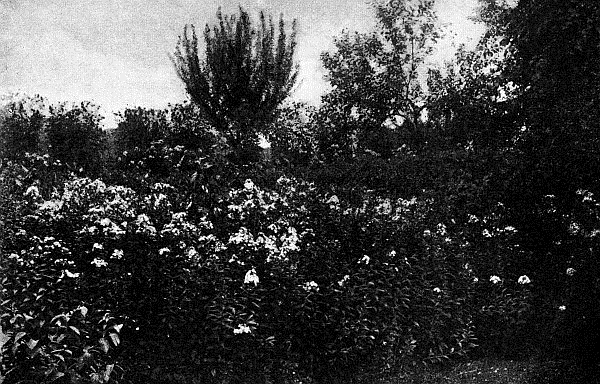
A mass of Phlox; Rudbeckias in the background
August second
PERENNIALS
CHAPTER VIII
PERENNIALSSome of the perennials to be sown yearly in the seed-bed from about April first to tenth, are the following:
Columbines of all varieties, yellow, white, shading from pink to red and from pale blue to darkest purple.
Of Columbines every garden should have plenty. Blooming about May twentieth for three weeks, they are a perfect delight. They are very hardy, germinate readily in the seed-bed, are easy to transplant and need but little care. I have never been able to get them much over three feet in height, but then I have often a dozen stalks of bloom on a single plant, which is very satisfactory. The first dozen plants were sent to me by a friend from his garden on Long Island; now I have hundreds of them, – single and double, white, yellow, all shades of red and pink, pale blue, and a blue one with a white center almost like an Orchid; many shades of purple, also purple and white.
Hollyhocks, single and double, of all colours. In order to get the desired colour effect with these, keep each variety separate.
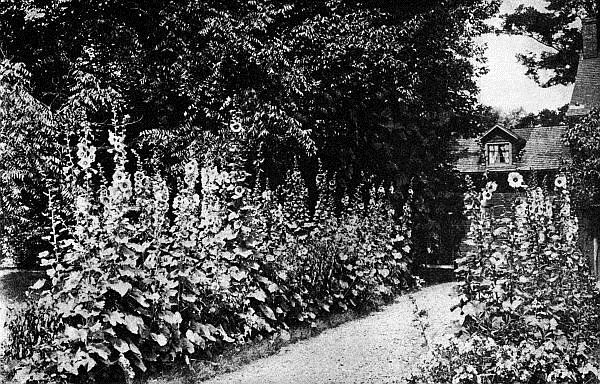
Hollyhocks in blossom
July twelfth
No one can have too many Hollyhocks. Plant them at the back of the borders among the shrubbery, along fences, and in great clumps in any odd corner, or around buildings; they are never amiss, and always beautiful. I find that a Hollyhock cannot be counted upon to bloom more than three years. First-year stalks are about four feet high; afterwards, if in good soil, they will be from six to eight feet. There were hundreds of this size in my garden last summer, each plant with from three to five towering stalks of bloom. As soon as they have gone to seed, I save what seed I want and the stalks are then cut down and burned. By sowing the seeds as soon as thoroughly ripe and dry, plants can be raised which will be large enough to transplant in October, and will bloom the next year. These young plants should be given a slight covering the first winter, that they may not be winter-killed.
When in a border, the Hollyhock, which will flourish in any soil, grows to such an extent that Lilies or Phloxes, or anything else near by, are likely to be crowded out, unless care is taken to cut off the lower leaves, which become enormous. I have this done usually three times before they bloom, beginning early in May, and great wheelbarrow-loads of leaves are taken away at each cutting.
Sweet Williams, red, white and pink. These will grow from eighteen inches to two feet. The stems are straight and stiff, and the trusses of bloom about five inches across, with individual flowers as large as a nickel; they keep well in water and make a beautiful edging for a border, or give great effect when planted in masses. They bloom for three weeks or more, and make fine decorations for church or house.
Platycodon Mariesi, beautiful blue; they resemble Canterbury Bells, and, as they blossom after the Canterbury Bells, are valuable in continuing the period of blue flowers, with the advantage of being perennials.
Delphiniums, perennial Larkspurs, all varieties. These seeds I have found more difficult to make germinate than any others, so I do not rely upon what I raise, but purchase many plants. My best results have come from saving the seeds from the first crop of blossoms, drying thoroughly, and then sowing at once. I have found these seeds more sure to germinate than those bought in early spring. Perhaps nature intends them to be sown in this way, instead of nine months later.

